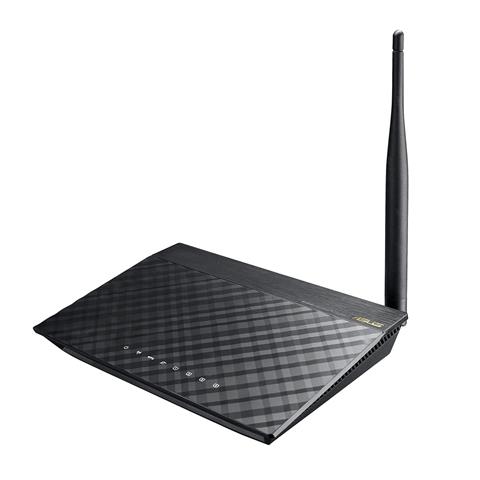
This is ASUS' lowest-cost router. There doesn't seem to be that much information about it, and as SmallNetBuilder has not reviewed it, I figured I'd review it in their style.
I managed to pick one up for $15 with free shipping. Searches indicate it has sold for as low as $8.99 after rebate. Is a $15 router any good?
Overview
As an entry-level, basic router, it uses 10/100 ports along with single-radio N150 wireless.
FCC internal photos are dated May 11, 2013 so the device is still fairly new. They show a very sparse board:

The heart of the router is the Broadcom BCM5357 SoC. It's an all-in one device and includes a 300 MHz MIPS 74K processor, a 10/100 Mbit switch and a single 2.4 GHz 802.11n radio. To the right of the SoC is 32 MB of RAM (EtronTech EM63A165TS-6G) and to the bottom left is 8 MB of flash. There is no external radio amplifier, it is incorporated into the BCM5357.
As the underside of the board has very few unremarkable components, the only other item of note is the single rather large external antenna:

This 5 dBi antenna is larger than the antennas on the RT-N66U. It is non-replaceable but fully positionable in all directions.
Cosmetically the RT-N10P follows ASUS' current design - it therefore appears just about identical to their other routers. Compared to the RT-N66U it is a little smaller in both dimensions but is the same height and the angles on the case are the same. The indicator LEDs are inside the translucent case just like the RT-N66U although these are round and green rather than square and blue. There's a full complement of LEDs: power, radio, WPS, WAN and 4 LAN link/activity. This is nice to see as some manufacturers are eliminating most of these helpful diagnostic indicators.
The only unusual component on the back panel is an on-off pushbutton - this is handy for power-cycling the unit rather than pulling the power connector, then reconnecting it. There is also the standard recessed reset button, 4 LAN ports, a WAN port and a WPS button.
The unit runs very cool, there's an almost imperceptibly warm spot at the centre of the case. I would assume this is just above the SoC. My RT-N66U runs much hotter.
Features
I'm familiar with the RT-N66U which cost over 10 times as much at the time. Both routers run ASUSWRT firmware so the look and features are the same. These features include:
- multiple SSIDs with different access levels
- QoS
- VPN
- WDS
- access restrictions
- repeater and AP modes
These are complete and impressive features for an entry-level router.
Wireless Performance
I measured the signal strength in several locations throughout my small home using inSSIDer. As expected, its signal strength was always lower than my RT-N66U signal strength. However there were no dropouts, it connected reliably everywhere.
I used an Intel Centrino 5300 AGN adapter in an HP EliteBook 8530w for testing. It is a 3-stream dual-band N450 adapter. Speeds were tested using iperf on a Linux server and on the HP. iperf's simultaneous bidirectional testing method was used, which generates traffic flow from both the server and the client simultaneously - this saturates the connection thoroughly. As there are other 2.4 GHz networks in the area, channel bandwidth was limited to 20 MHz automatically - this lead to a sync rate of 72 Mbps on the wireless client software.
Tests were conducted twice and averaged. Speed obviously was not as high as the RT-N66U but was impressive nevertheless.

Wireless Bridging Using Alternative Firmware
My main objective for buying this router was not as a router or as an AP, but as a wireless bridge to replace an old Linksys WRT54G which was performing this function. This is not practical with the RT-N10P default firmware - it can do this using WDS, but the bandwidth is halved and the wireless security must be reduced to WEP or deactivated. This is obviously not acceptable.
Alternative firmware can accomplish this quite easily though, as my WRT54G running DD-WRT showed. Some research indicated that Tomato - Shibby is the most advanced, well-supported alternative firmware for this router. This is the lowest-cost router that will support alternative firmware. Loading it onto the router cannot be done through the web interface though, you must put the router into emergency firmware recovery mode and flash it using a PC running ASUS' firmware recovery utility. This worked almost perfectly - the only minor issue was the misidentification of the LAN ports. Selecting Tomato's "invert port order" setting eliminated this issue.
Tomato adds even more features but the one I was most interested in was "Wireless Ethernet Bridge". I enabled this, associated it with my RT-N66U wireless network and conducted some tests.
In my desired location in my entertainment centre, the same iperf tests as above showed 41.75 Mbps average. This seems to be the top wireless speed of the router. In contrast, the same tests on the WRT54G came to 23.68 Mbps.
Conclusion
For $15 I have nearly doubled the speed of my bridge and taken an old 802.11g device off my 802.11n network.
I would highly recommend the RT-N10P for use as a router, AP or wireless bridge (using alternative firmware) if the router is on sale. At regular price, the 2-radio 300 Mbps RT-N12 D1 is only a few dollars more. It is otherwise identical to the RT-N10P but would offer increased bandwidth both as a router and as a wireless bridge if your main AP/router was 300 Mbps or better. But for $10 or $15, the RT-N10P offers excellent performance for the money.
Check NewEgg
Last edited by a moderator:

